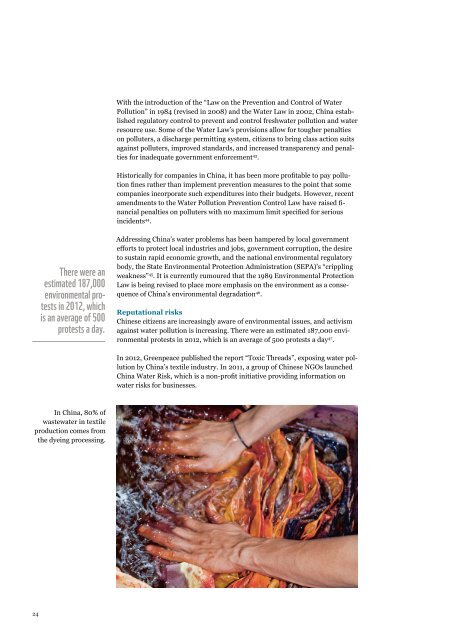YtDl2r
YtDl2r
YtDl2r
Create successful ePaper yourself
Turn your PDF publications into a flip-book with our unique Google optimized e-Paper software.
With the introduction of the “Law on the Prevention and Control of Water<br />
Pollution” in 1984 (revised in 2008) and the Water Law in 2002, China established<br />
regulatory control to prevent and control freshwater pollution and water<br />
resource use. Some of the Water Law’s provisions allow for tougher penalties<br />
on polluters, a discharge permitting system, citizens to bring class action suits<br />
against polluters, improved standards, and increased transparency and penalties<br />
for inadequate government enforcement 43 .<br />
Historically for companies in China, it has been more profitable to pay pollution<br />
fines rather than implement prevention measures to the point that some<br />
companies incorporate such expenditures into their budgets. However, recent<br />
amendments to the Water Pollution Prevention Control Law have raised financial<br />
penalties on polluters with no maximum limit specified for serious<br />
incidents 44 .<br />
There were an<br />
estimated 187,000<br />
environmental protests<br />
in 2012, which<br />
is an average of 500<br />
protests a day.<br />
Addressing China’s water problems has been hampered by local government<br />
efforts to protect local industries and jobs, government corruption, the desire<br />
to sustain rapid economic growth, and the national environmental regulatory<br />
body, the State Environmental Protection Administration (SEPA)’s “crippling<br />
weakness” 45 . It is currently rumoured that the 1989 Environmental Protection<br />
Law is being revised to place more emphasis on the environment as a consequence<br />
of China’s environmental degradation 46 .<br />
Reputational risks<br />
Chinese citizens are increasingly aware of environmental issues, and activism<br />
against water pollution is increasing. There were an estimated 187,000 environmental<br />
protests in 2012, which is an average of 500 protests a day 47 .<br />
In 2012, Greenpeace published the report “Toxic Threads”, exposing water pollution<br />
by China’s textile industry. In 2011, a group of Chinese NGOs launched<br />
China Water Risk, which is a non-profit initiative providing information on<br />
water risks for businesses.<br />
In China, 80% of<br />
wastewater in textile<br />
production comes from<br />
the dyeing processing.<br />
24


